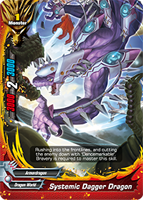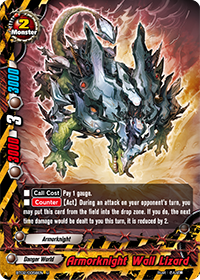 |
| The definition of mediocre |
But hey, he has the same power as defense. That's kinda neat.
Moving on, we now take these illegal 50 card decks and play against each other, to see how going first will affect our chances of winning.
Rock. Paper. Scissors! Okay, I win, and I'm going first. Draw 6 cards and gauge 2. Well, the gauge is pretty useless since I'm not going to pay anything with this deck (and I know that I've gauged 2 Systemic Daggers anyways). So I'm probably not going to Charge and Draw, like, ever. So I don't. There's no point, anyways. And since I'm going first, I don't get to draw. That's okay, I can attack first and make it worth it (2 damage = 1 card).
Current advantage: 0-0 cards on field, 6-6 cards in hand, 10-10 life
But now I stumble into a problem. Sure, I'm definitely going to call a Systemic to center and attack with it. But...should I call any more? This is a big deal in Buddyfight. As the player going first, just how many monsters are you supposed to call?
 |
| Hurry up, Shidou needs to know how many dragons to call |
Route 1: Call 1 monster to center and attack.
Route 2: Call 1 monster to center, 1 to side, attack.
Route 3: Call 1 monster to center, 2 to side, attack.
In each of the cases, the player going first would have gained net +1 in advantage for 8 vs. 6. The difference lies in the hand size as opposed to the field size. Let's take a closer look.
End of Turn 1 (First)
Route 1: 1 on field, 5 cards in hand, 10-8 life
Route 2: 2 on field, 4 cards in hand, 10-8 life
Route 3: 3 on field, 3 cards in hand, 10-8 life
Turn end.
Your turn. Draw, but no charge and draw (not that it matters). You now have 7 cards in your hand. It would be utterly brainless of you NOT to call a full field and to take advantage of 3 attacks. So you call a full field. Now you have to decide. Do you want to attack the field or me directly after you delete my center monster?
As my Field Control article shows, NOT attacking the field is really, really stupid. When you attack the field, not only are you making your one attack worth it, you are destroying one of your opponent's chances of attacking. And attacking is what gains damage advantage. So the rule for this exercise is, attacking the field is superior to attacking the opponent.
Let's look at the 3 routes again, assuming that you (my opponent) calls a full field and acts on the above assumption (first number is me, second is you)
End of Turn 1 (Second)
Route 1: 0-3 on field, 5-4 cards in hand, 6-8 life
Route 2: 0-3 on field, 4-4 cards in hand, 8-8 life
Route 3: 0-3 on field, 3-4 cards in hand, 10-8 life
It's perfectly balanced! Well, duh, we've been using a perfectly balanced deck that will not be able to generate any sort of advantage by itself. And now you're thinking what the whole point of this exercise is. Stop complaining and let's continue.
Draw. I obviously call a whole field and attack optimally.
End of Turn 2 (First)
Route 1: 3-0 on field, 3-4 cards in hand, 6-8 life
Route 2: 3-0 on field, 2-4 cards in hand, 8-8 life
Route 3: 3-0 on field, 1-4 cards in hand, 10-8 life
Same goes for you.
End of Turn 2 (Second)
Route 1: 0-3 on field, 3-2 cards in hand, 6-8 life
Route 2: 0-3 on field, 2-2 cards in hand, 8-8 life
Route 3: 0-3 on field, 1-2 cards in hand, 10-8 life
Draw...crap. If I went Route 3, at this point I only have 2 cards in my hand. I can't call a full field.
End of Turn 3 (First)
Route 1: 3-0 on field, 1-2 cards in hand, 6-8 life
Route 2: 3-0 on field, 0-2 cards in hand, 8-8 life
Route 3: 2-1 on field, 0-2 cards in hand, 10-8 life
Take a moment to look at Route 2. Since field advantage and hand advantage are the same, Route 2 is even in life but the player going first has gained an extra card advantage.
End of Turn 3 (Second)
Route 1: 0-3 on field, 1-0 cards in hand, 6-8 life
Route 2: 0-3 on field, 0-0 cards in hand, 8-8 life
Route 3: 0-3 on field, 0-2 cards in hand, 8-8 life
Whoa whoa whoa WHOA. Stop the press. What is up with Route 3?
Since I could only call 2 Systemic Daggers to the field and thus was forced to leave a Systemic Dagger uncleared, it means that my opponent doesn't have to replace it. He gets a free attack from it, as stated in my Field Control article. Additionally, since he has a full field, he can clear my field and deal damage to me with one remaining attack. Obviously I'm in a clear losing position now.
Starting Turn 4, NO Routes will be able to call a full field.
End of Turn 4 (First)
Route 1: 2-1 on field, 0-0 in hand, 6-8 life
Route 2: 1-2 on field, 0-0 in hand, 8-8 life
Route 3: 1-2 on field, 0-2 in hand, 8-8 life
Then...
End of Turn 4 (Second)
Route 1: 0-2 on field, 0-0 in hand, 6-8 life
Route 2: 0-3 on field, 0-0 in hand, 4-8 life
Route 3: 0-3 on field, 0-2 in hand, 4-8 life
Eh? What happened to Route 2? Same story as Route 3. Since I couldn't clear the field, my opponent was able to gain free attacks. Route 2 seems dead now as well.
Final Turn.
End of Turn 5 (First)
Route 1: 1-1 on field, 0-0 in hand, 6-8 life
Route 2: 1-2 on field, 0-0 in hand, 4-8 life
Route 3: 1-2 on field, 0-2 in hand, 4-8 life
One more.
End of Turn 5 (Second)
Route 1: 0-2 on field, 0-0 in hand, 4-8 life
Route 2: 0-3 on field, 0-0 in hand, 0-8 life
Route 3: 0-3 on field, 0-2 in hand, 0-8 life
So we see here that calling ANY monsters besides the one you are planning on attacking with in the center is just not efficient, assuming that your opponent understands field control and prioritizes the field over you.
If you look at Route 1 (the only route that managed to survive to T5), you realize that the person who goes first is at a serious handicap. He's down not only in cards, but also in life. At the end of Turn 6 (First), he would have made up the card deficit (but would still be down -2 life). And when Player 2's turn rolls around he'd be back in the same situation as above, down 2 cards on field but 4 life, a total of -3. And each turn after, he'd be losing 2 life a turn until his eventual loss. Wow. Going first sucks.
 |
| Best starting gambit PERIOD |
Buddyfight is one of those games where you start with essentially all the advantage you will ever get and then just minus yourself into oblivion. The way you manage your resources and direct your attention is the key to getting a foothold over your opponent. Going first isn't necessarily a bad thing, as long as you take advantage of the fact that you get to set the tempo and pace of the rest of the game.
All images were used obtained from the official Bushiroad website and used here solely for reference purposes. Future Card Buddyfight!, logos, and respective content belong to Bushiroad. Large images belong to the Buddyfight! Wikia.

what about not clearing fields. first player t1 play attack for 2, t2 play 3 clear mid attack for 4, t3 clear mid attack for 4. this requires 7 cards and on turn 3 you will have 8 cards. The dmg you recieve will be 4 dmg on t1, 4 dmg on t2. There is no t3 as you win on t3. Hence guarantee you win the game.
ReplyDeleteUsing your decks player 1 will always win given optimal strategy hence goinf first is advantaged
Hmmmm. You're actually talking about something entirely different there, which is winning. You're addressing how to win Buddyfight by reducing your opponent's life to 0. That's (obviously) what you want to do, but Buddyfight is a card game and this is an article about card advantage. While sure, prioritizing face would actually win you the game in this really weird example, it actually loses out on card advantage really quickly.
DeleteThis is because in Buddyfight, your starting life pool is only 10 life which equivalent to about 5 cards/attacks. 5 attacks is really easy to achieve when you can hit 3 a turn, which means that rushing is a very rewarding strategy. Your example is a verification of that.
But please, are you seriously going to use my lolsack scenario as proof that player 1 will have the "optimal strategy"? These decks aren't even legal. With real standardized decks, player 1 is more often behind from losing 0.5 from charge and draw and not being able to generate more than 1 attack.